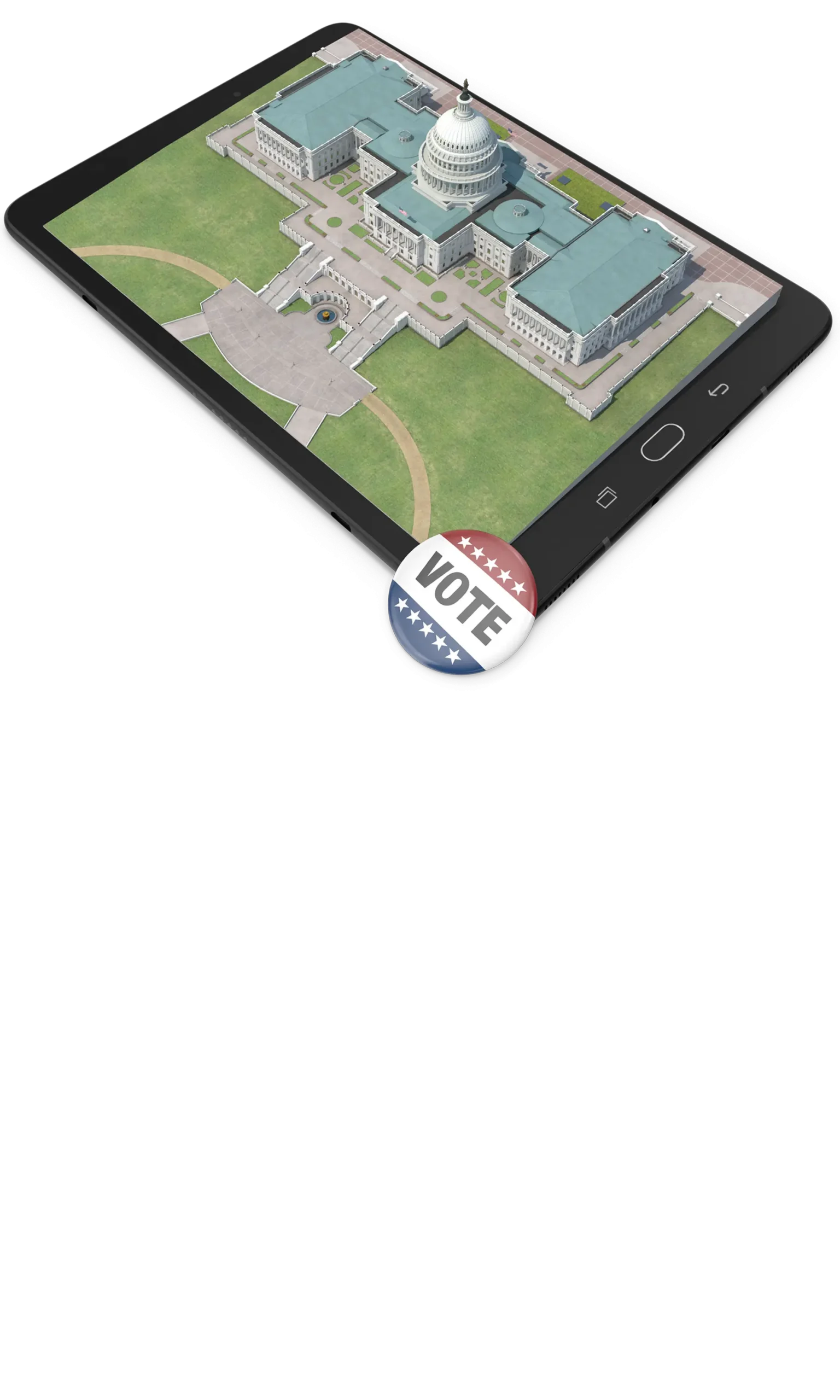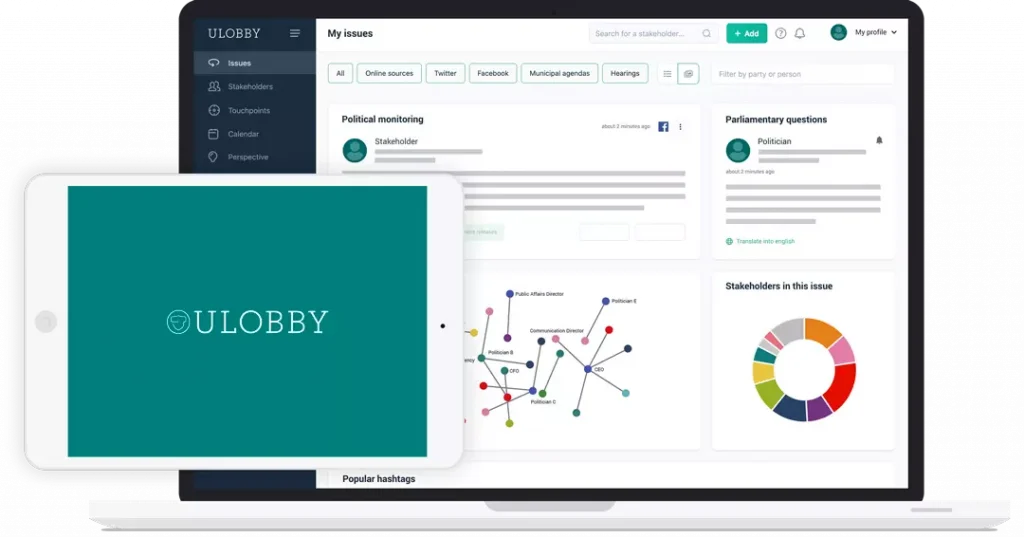Articles & guides
Digital Public Affairs: how to employ effective institutional communication
in a nutshell
The definitive guide to digital institutional relations and digital public affairs in the age of digital transformation, with insights about advocacy and lobbying, and a downloadable position paper canvas to publicly state the position of your company.


Don’t have time to read it all?
Here’s a brief summary of the key points in this guide.
What are digital public affairs?
We could define public affairs as the relationship between businesses and political organizations aimed at promoting constructive exchange between the actors involved. Today, the determining factor to successfully manage public affairs is technology, because:
- • It facilitates exchanges and connections
- • It helps make everything more transparent
- • It redesigns and “reengineers” business processes
- • It speeds up operations by minimizing the chance of error
- • It ensures greater control and verifiability over the execution of each task
[DIVE IN]
And what about digital institutional relations?
Institutional relations are precisely those activities of relations and representation carried out by individuals or professional firms on behalf of companies, economic associations, nonprofits, or even simple private citizens or consortia, towards political bodies and public administrations.
Here, the advent of digital is proving to be more than helpful:
- • It creates integrated strategies to play ahead of institutional scenarios and build profitable dialogue with politicians and stakeholders
- • Data, Artificial Intelligence, and machine learning facilitate the public-private correspondence and mutual understanding
[DIVE IN]
How do you implement successful advocacy and lobbying strategies?
“Advocacy” means to defend, to advocate on behalf of others. By leveraging data and technology, it is now possible to do advocacy in a highly focused, methodical, and impactful way, on a significantly large scale. This public affairs strategy can be improved through the adoption of digital practices:
- • Digital adds an important element of transparency
- • We can determine opinion by distilling viewpoints through AI-enabled tools
- • Digital platforms built specifically to manage public affairs programs, such as Quorum and Ulobby, allow us to oversee issues and stakeholders in one place
- • By using technology we could build far larger, more targeted, more effective communities of supporters
- • Digital raises the general level of knowledge and reduces unnecessary duplication
Lobbying is a perfectly legitimate way of participating in the legislative and public decision-making process. Appointed professionals will seek to influence the choices of policymakers in relation to the objectives of the company they work for. Those involved in lobbying activities:
- • Identify stakeholders
- • Develop a mapping of key decision-makers and influencers
- • Define and promote an accreditation pathway with decision-makers
- • Carry out direct advocacy activities
- • Are not involved in the actual decision-making process
The underlying goal is to consolidate relationships that are considered strategic for creating and maintaining a positive image of the company represented.
[DIVE IN]
How do I produce an efficient position paper?
A position paper, no matter what, should:
- • Begin with a few lines summary of the problem under consideration
- • Continue with the antithesis (the most objective refutation of opposing views possible)
- • Present the represented company’s position on the matter
- • Refer to fairness and morality (just enough)
- • Highlight the impact of the matter on the company’s activities
- • Make arguments that do not just mention the loss of profit, but also play (without exaggeration) on the emotional side
- • Illustrate third-party approval (this may be worth more than your own arguments)
- • Show the impact on customers (since they should share the same interests of the company)
[DIVE IN]
LEARN TO RIDE
Ready to surf the digital wave and become a leader in your industry? Join Execute.Club, where executives and managers like you can access resources, connect with peers, and get the no-nonsense help you need to succeed in the digital era.
Enter the ClubIntroduction
We could define public affairs as the relationship between businesses and political organizations aimed at promoting constructive exchange between the actors involved. In this way, businesspeople can influence legislation and politicians receive important information of national interest from business. Digital public affairs, therefore, helps ensure that a company’s goals remain in line with real-world developments. Only then can it become a credible player capable of dictating and guiding sustainable development.
An introduction to Digital Public Affairs
Digital transformation is an inevitable process of change that every modern enterprise must make sure to embrace. It is a revolution in business models that redesigns internal organization and improves relationships with customers, stakeholders, and policymakers. In fact: digital transformation forgets no one, least of all the public and institutional sector, which can only benefit from the technological growth of the private sector.
Nowadays, in order to adequately deal with a constantly changing political, social and communicative environment, internal renewal in organizations is necessary. This means strengthening collaboration between departments, knowing how to manage risk preventively, introducing innovative professional figures and adopting more transparent behavior. A renewal, therefore, structural, operational but also cultural.
So, a metamorphosis involving, transforming, and streamlining institutional relations and regulatory affairs with related lobbying and advocacy strategies, even to the point of reshaping the concept of position paper. In the next paragraphs, we will understand how rampant digitalization has affected so-called public affairs activities: the building of a dialogue between business and politics, to establish or consolidate a relationship between any stakeholder and political-institutional public decision makers.
The true meaning of digital transformation
Wait a minute: before we go any further, we should make sure we understand what embracing digital really means for a company. Adopt smart working, perhaps? Working remotely is convenient, no doubt, though perhaps a bit boring at times. It allows us to participate in meetings and events in the virtual world, and it saves us lengthy early morning vis-à-vis conversations. But it is not enough.
Going digital does not mean transferring the set of activities previously done offline to the network, because it does not change their nature, only the way they are done. The real shift to technology is a process that, when applied to the vital components of a business, can have a disruptive effect. The use of digital and interconnected means not only replaces offline activities, but drastically improves them. Today we have intelligent tools that are based on extracting useful, objective and quality information through the collection and analysis of a huge amount of data. And this is where public affairs can step in.
What are Digital Public Affairs?

Effective collaboration between the private world of business and the public world of institutions is, needless to say, of crucial importance in today’s changing and unpredictable marketplace. Dialogue between private and public affairs is favorable for both sides, as it gives small and medium-sized businesses in particular an opportunity to have their voices heard in the legislative process, and institutions obtain comprehensive reports on politically relevant topics.
To recap: a successful enterprise must have great solutions for great problems. Optimal management of public affairs ensures alignment with popular sentiment and the support of political capital. And what is, today, the determining factor for having such success? That’s right: technology. Digital facilitates exchanges and connections, particularly to those who generally would not have had access to the halls of power.
But it also helps make everything more transparent. So digital transformation must be the first thought of a modern enterprise. Digitalization of business processes means redesigning and “reengineering” them, taking advantage of the automation modules provided by modern technology platforms. It means speeding up operations by minimizing the chance of error and ensuring greater control and verifiability over the execution of each task.
The digital avalanche has now also swept over every activity related to public affairs: we are talking, more specifically, about institutional relations and regulatory affairs. Two professions that affect public-private relations in different ways, and which have welcomed technology into their modus operandi.
Communication is the key
Public relations and the importance of effective communication
A company, whether small, medium, or large, in order to function according to an effective strategy, cannot neglect any aspect that can guarantee it consensus and value. And we have seen how a proactive attitude in dealing with institutions is a key factor for a company that wants to succeed in every respect. It benefits the company’s image at the political level and at the level of the people.
But it is good to remember that without accurate digitalization any attempt to build effective public relations would prove futile. After all, we go through an era in which winning attention is itself no small challenge. If we then consider the climate of distrust and apathy that usually prevails, we understand how challenging it can be indeed to position oneself and succeed in shaping a rather demotivating external environment.
However, don’t lose hope! Public affairs have never been as important to political communication as they are today. In fact, board members, CEOs and public relations managers in any sector find themselves communicating more and more intensively with an ever-increasing number of diverse groups. Thus, the key word is “communicate”: really effective communication does not just convey information, but stimulates public opinion, induces action and a change in the way people think and behave.
Digital Public Affairs: who should you contact?
Well, by now it should be clear the importance of public relations: the institutional counterpart must be put in a position to be able to communicate easily, immediately and collaboratively with the company. Therefore, it will first be necessary to find the right way to relate to the relevant public or political organization. Since these are varied aspects and complex procedures, it might almost seem obvious to suggest not relying on improvisation, but carefully choosing a specialist.
They could also be an internal employee, or the result of a completely autonomous initiative of the executive board. Or, again, an external consulting firm taking charge of the entire communication mission (probably the happiest and safest choice). After all, in public relations, it would be best to demonstrate good – if not in-depth – knowledge on the subject: that is, we are talking about an operation that monitors the evolution of regulations affecting the areas of interest of private parties and the compilation of a periodic and comprehensive report related to the process of legislative measures.

Institutional Relations & Regulatory Affairs
Digital Institutional Relations
Consulting firms are necessary intermediaries in a company’s public affairs, as they provide their expertise in communication and legislation to facilitate dialogue between business and politics. Thanks to digital, moreover, the possibilities for building a reputation and concretely influencing society are endless. New creative storytelling techniques, mutual exchanges and conditioning with allies and competitors, use of online tools and software that simplify complex programs. All supported by the protagonists of the modern era: lots of small, sophisticated data.
Be careful, though: public relations performed by specialists in the field should not be understood as mere political advice. Consultants lend themselves to mediation between public and private affairs to facilitate the productive exchange of information that can serve both sides in the most transparent context possible. In the most genuine sense of the term, there is no manipulative intent, only honest communication, and the making of shared agreements.
Public affairs officers can represent the interests of public institutions, companies, associations, parties, and nongovernmental organizations at a European level. They may be responsible for informing their employers or clients about relevant developments in EU countries and indulge their interests in decision-making and communication strategies.
Institutional Relations: what does it mean?
By now, it is finally time to introduce another concept closely related to the world of public affairs: Institutional Relations. These are precisely those activities of relations and representation carried out by individuals or professional firms on behalf of companies, economic associations, nonprofits, or even simple private citizens or consortia, towards political bodies and public administrations. But initiatives promoted by economic or territorial public bodies towards other institutions, always involving specialized employees or external consultants, can equally be considered Institutional Relations.
Lead firms define medium and long-term strategic goals and support clients in developing institutional relationship strategies, so that they can establish direct and solid contact with decision-makers. The aim is to begin with an analysis of the regulatory and legal environment in order to build a lasting relationship based on expertise and networking. Interventions usually rest on in-depth knowledge of decision-making dynamics, often experienced firsthand. Public relations professionals curate initiatives involving governments, parliaments, central and local governments, and even independent authorities. Always with the focus on ensuring transparent information that satisfies all social groups involved.
Digital Regulatory Affairs
We have seen how digital communication experts in public affairs share a deep understanding of institutions and their dynamics. They confront each other on a daily basis, to the point of developing a very active political-institutional relations network. We also have seen that consultants (or anyone involved in institutional relations) must demonstrate exemplary communication skills, as well as moral honesty and clarity in order to work with clients, journalists, and politicians in a serious and trustworthy manner.
Finally, the advent of digital is proving to be more than helpful in creating integrated strategies to play ahead of institutional scenarios and build profitable dialogue with politicians and stakeholders. Data, Artificial Intelligence, and machine learning are jumping into the public-private correspondence to facilitate their meeting and mutual understanding.
But, among public affairs, there is still to be considered an aspect that we might call complementary to the Institutional Relations just analyzed. We are talking about Regulatory Affairs, a world of professionals who work to make sure that a company’s production complies with the laws in force, and thus obtains all the consequent permits necessary to be put on the market.
Regulatory Affairs – an overview
That’s right: it is not enough to have competition, which, by itself, hinders or slows a product’s entry and growth in the market. All the careful analysis aimed at unearthing strengths, weaknesses, opportunities, threats, internal factors, and external factors to ensure that we have a product or service on our hands that truly meets consumer needs risks being thwarted if it fails the regulatory test.
So, remember to keep an eye on the legislation and regulations that affect your offering of goods or services regarding, for example, quality control, privacy compliance, security standards, copyrights, and a whole range of legal standards that absolutely must be met. But don’t panic: regulatory activity as it is set up today is no longer the responsibility of the individual.
It requires, in fact, the involvement of multiple actors who, if possible, should contribute with different types of culture (technical, scientific, and administrative) and a good knowledge of languages. It is important, in fact, not only to be familiar with one’s own national regulations, but also those of European and non-European countries.
The regulatory affairs system thus inevitably affects the marketplace: increasingly rigid and complex regulations and practices have contributed over time to a demand revolution. But regulatory experts step in to support companies in establishing a dialogue that is nurtured by shared goals and proven expertise. Collaborative relationships and discussion between companies and intermediaries can go as far as mutual respect, culture and knowledge go. This is because it is not enough to keep in mind the rules of control, efficiency, and reduction of complexity: it is principles such as trust, integrity and reputation that are becoming increasingly critical.
Do you have a Public Affairs & Comms challenge to tackle? Let’s face it. Together.
C-levels from these companies (AND MORE) relied on my expertise to overcome thEIR CHALLENGES IN THIS AREA. And you can, too.
Can I help you?Advocacy & Lobbying
Advocacy and Lobbying: what are they and how they change with digital
It is time to address the strategies applied by consulting firms and typically related to public affairs, both in the field of Institutional Relations and Regulatory Affairs. We are talking about advocacy and lobbying, activities implemented by the introduction of digital and used by experts in favor of private parties in their relationship with public affairs, without the latter being circumvented or harmed.
What is advocacy?
The logic behind advocacy is quite clear: a company asks a credible third party to support its cause, and the legitimacy of the company’s efforts will thus be enhanced. By leveraging data and technology, it is now possible to do advocacy in a highly focused, methodical, and impactful way, on a significantly large scale. “Advocacy” means to defend, to advocate on behalf of others. And digital advocacy is now necessarily an integral part of most public affairs programs. Specialized companies do advocacy on a large scale by deftly maneuvering between data and digital, and ultimately turning people into active advocates.
For a company, we can identify two types of advocacy: employee advocacy and consumer advocacy. Both are based on the degree of satisfaction derived from the company’s product, service or mission. But perhaps also on the transparency of actions, customer service or the ability to create added value. Consumer advocacy is the most desirable final destination of a customer journey: the customer voluntarily becomes a promoter and ambassador of the brand. Employee engagement, on the other hand, is about the emotional investment and loyalty that a company’s people feel toward their own workplace and toward the internal organization.

Information improves efficiency. As a result, knowing as accurately as possible what a company looks like in the minds of customers, employees and stakeholders is vital information, which has been made accessible by data-driven IT tools. Digital platforms such as Quorum and Ulobby have been created specifically to manage public affairs programs and thus oversee issues and stakeholders in a single environment. Consensus building in the relationship between business and institutions needs new techniques and methods: an integrated approach between advocacy, public affairs, and media relations that ensures the transparent representation of legitimate interests shared by state and private organizations.
What is lobbying?
Let’s dispel a myth: the term lobbying does not necessarily have a negative connotation, rather the opposite. It is a perfectly legitimate way of participating in the legislative and public decision-making process, during which one makes contributions to protect the interest represented. In simpler words, appointed professionals will seek to influence the choices of policymakers in relation to the objectives of the company they work for. Those involved in lobbying activities:
- • identify stakeholders
- • develop a mapping of key decision-makers and influencers
- • define and promote an accreditation pathway with decision-makers
- • carry out direct advocacy activities
- • are not involved in the actual decision-making process
The underlying goal is to consolidate relationships that are considered strategic for creating and maintaining a positive image of the company represented. This will benefit the quality of relationships with key stakeholders.
The professional figure involved goes by the name of lobbyist, and is, basically, a kind of ambassador who acts as a spokesperson for a private individual’s particular and legitimate interests, bringing them to the attention of public or institutional decision makers. And here, again, the contribution of digital transformation emerges. Indeed, legislative bodies demand a lot of information before legislating, repealing, correcting, or amending acts passed or to be passed. Therefore, a management model supported by digital tools and open data becomes the dream of every contemporary lobbyist, as it transports interest defense and advocacy to a more advanced level.
Lobbying could thus be said to be a form of persuasion that can contribute to the improvement of public decision-making processes in all respects. However, despite the fact that there is a tendency to think that the course of influence travels unilaterally toward state authorities, many institutional sectors themselves use interest groups for the formulation and implementation of policy measures. This means lobbying takes on the character of an effective exchange of information, which seeks to exclude the concepts of bribery and granting of benefits often associated with the term. In any case, such a relationship with institutions allows for the submission of amendments and position papers, which is our next topic.
But first, some digital practices
Traditional digital public affairs strategies like advocacy and lobbying still work, but their success can be accelerated through the adoption of digital practices. And don’t forget digital also adds an important element of transparency which gives further legitimacy and integrity to the actions you take. The public itself can engage and support your lobbying activity, e.g., placing decision makers on check to do more.
So, digital transformation is making its way through public affairs. But the path is slow and winding. It must first undergo the steps of digitization and digitalization – which are not yet real business revolutions. Almost every activity has the potential to be moved to a digital process, yet only a small subset is. We can summarise some of the areas where digital transformation has already made headway in public affairs.
Digital advocacy at scale
EU public affairs tend to eschew advocacy at scale, preferring smaller and archaic activities we call “third parties” or “key opinion leader mobilisation”. But by using technology we could build far larger, more targeted, more effective communities of supporters. Hear hear – this works even for industries that may not believe they have many supporters. In the U.S., some predict that digitally-driven corporate advocacy will eventually overtake lobbying spending within five years.
Faster & better sentiment analysis
Today, we are able to determine opinion by distilling viewpoints through AI-enabled tools. By using deep learning tools, analyses of both wider publics and narrower groups can determine their positions on a certain issue, how strongly they feel about it, and how they are likely to respond to a certain argument, without the need to invest in expensive and often unreliable polling and focus groups.
Predicting the political outcome
Following the logic of distilling large amounts of data (from public statements through to past voting behaviour), we are now able to predict the likely positions policymakers will take quickly and efficiently. Obviously, experience, intelligence and gut will probably still enable some people to come to some of the same conclusions. But why not to do it do it rationally, faster and more efficiently?
Effective stakeholder management
Digital platforms built specifically to manage public affairs programs, such as the already mentioned Quorum and Ulobby, allow us to oversee issues and stakeholders in one place. And this could easily enhance efficiencies. Also, since everyone has the same information, the general level of knowledge is raised and unnecessary duplication is reduced.
The position paper
What is a position paper?
In the field of public affairs, the position paper plays a very practical role. It is a written document that is intended to publicly state the position of an organization on a particular issue. It must meet a number of characteristics, making it recognizable both formally and in terms of content. First of all, it needs to refer to the facts accurately, and it needs to set out the remarks it contains in a way that appears reasonable and moderate. Therefore, if the goal is to convey firmness and persuasion, it will be good to avoid threats and excessive impulsiveness. Nor should the position paper be a soporific papyrus: it is generally no longer than two pages.
DOWNLOADABLE FILES
- Position Paper Canvas – Download now!
There is also a component of originality, however, in the sense that it can take various forms: public testimony, speeches, press releases, publications addressed to employees or shareholders, and other media. In fact, however, the important thing is that the position paper limpidly illustrates the position taken by the company on a particular issue, trying to convince the audience of the goodness of the shared thought. And how would this be possible if not by accompanying the dissertation with the right amount of data, reliable sources and (digital) evidence?
Position paper: how to write it
Let’s get down to business. If you are looking for some guidelines to follow when writing a position paper, I am presenting a useful frame of reference below. Take care, however, to first be sure that you are in a situation that allows you to peep into controversy. First, is this an issue that concerns you? Can your company identify two distinct and contradictory positions? Are you personally interested in defending one of these two positions? Do you have sufficient arguments to defend your thinking? If the answer to all these questions is yes, then pick up your pc and write. A position paper, no matter what, should:
- • begin with a few lines summary of the problem under consideration
- • continue with the antithesis (the most objective refutation of opposing views possible)
- • present the represented company’s position on the matter
- • refer to fairness and morality (just enough)
- • highlight the impact of the matter on the company’s activities
- • make arguments that do not just mention the loss of profit, but also play (without exaggeration) on the emotional side
- • illustrate third-party approval (this may be worth more than your own arguments)
- • show the impact on customers (since they should share the same interests of the company)
It should be kept in mind that, for the dissertation to be successful, it is important that the organization presents all the points listed in the most easily understandable way for its audience. Also, once you have decided on the topic to be addressed, you must make sure that you are properly informed: a prior opinion is not enough! You need facts, verifiable and sharable information, data and statistics, remarkable and noteworthy opinions. And also, why not, the testimony of personal experience accompanied by a trusted witness to certify it.
Position Paper: some examples
To make the concept of position papers clearer, it will certainly help you to know a couple of practical examples. One was drawn up by the European Confederation of Independent Trade Unions (CESI), a body that brings together labor organizations from several European countries, including Italy. The other is related to Microsoft, a famous computer company founded in 1975 by billionaire Bill Gates.
1) Toward the end of 2019, CESI became part of the debate regarding the future of work – a key issue not only for its member unions and thus for the workers’ rights they aim to defend, but also for the European Commission itself. The Confederation’s position paper was entitled “The future of work: social protection, decent employment & interest representation“. The goal (the defended position) that the trade unionists aimed to achieve was to prolong the discussion on the labor market, which, overwhelmed by digitalization, could come out disrupted and highly diversified.
2) In March 2021 Microsoft took a stand against the European Commission on cybersecurity. Referring to the recent SolarWinds cyber-attack (a large-scale espionage operation) and calling for CESI’s own oversight, the multinational IT corporation called for greater transparency from defense digital infrastructure providers. The issue of online security and the protection of data and information is, nowadays, a crucial issue that governments and institutions must remedy and in which Microsoft felt obliged to intervene.
These are just two examples, but full versions of effective position papers that trace the suggested skeleton can be found on the web. Public Affairs has an important ally in this type of formal position statements.
So, what does Digital Public Affairs mean in concrete terms?
We have reached the end of the guide, and if you have come this far, it means that you are well-intentioned to embrace digital innovation in your company and pour it into every area, including institutional relations and regulatory affairs.
You are ready to hire an outside consultant or in-house employee to handle relations with political authorities and organize advocacy and lobbying strategies. And, to make sure you don’t miss anything, you are already architecting a position paper to finally take a stand on a thorny issue that has been nagging at you for some time.
But in concrete terms, then, what does Public Affairs mean? Let’s try to understand it once and for all:
- • It means political management of a company’s interests, through the strategic use of data and information and a joint effort in pursuing common industrial goals.
- • It means observation, analysis, and continuous monitoring of the political framework, i.e., the debates and legislative initiatives taking place in and between states.
- • It means lobbying, understood as a special form of persuasive communication that seeks to influence the course of legislative projects. In this sense, the position paper can be seen as a tactic of the lobbyist who wants to actively intervene in the political debate through public statements, participating in consultations or talking directly with decision makers.
- • It means social engagement by moving from political and sociopolitical debates concerning, for example, the labor market or the formation of basic civic attitudes.
- • It means cultivating a concrete relationship with customers, stakeholders, and political figures within the company’s constituency. Not forgetting local communication, good neighborly relations, community involvement, and contact with local government.

An important message for you
Hi there! I hope you found this article insightful.
Allow me to introduce myself. I’m Andrea Latino, the author of this article.
I have spent over a decade earning the trust of world-class multinationals, institutions and startups for their digital and innovation initiatives.
Are you curious about my story and how I could help you?
See how I can help youStay in wonderland
Let me show you how deep the rabbit hole goes.
Here are more Articles & Guides:

Articles & Guides
Digital Communication: how to develop an effective one
March 15, 2023

Articles & Guides
Digital Political Communication: doing politics in the age of social media
March 15, 2023

Articles & Guides
Digital PR: public relations in the digital age
March 15, 2023

Articles & Guides
Digital Public Affairs: how to employ effective institutional communication
March 15, 2023

Articles & Guides
Digital Transformation for Human Resources: stages, tools and new skills
March 15, 2023

Articles & Guides
Editorial Plan: how to build a winning one
March 15, 2023

Articles & Guides
Employee Journey: how to track employee experience in 6 simple steps
March 15, 2023

Articles & Guides
Innovation Strategy & Innovation Management: best practice and examples
March 15, 2023

Articles & Guides
Digital Tools & Innovation Resources: the best sources for your innovation process
March 15, 2023

